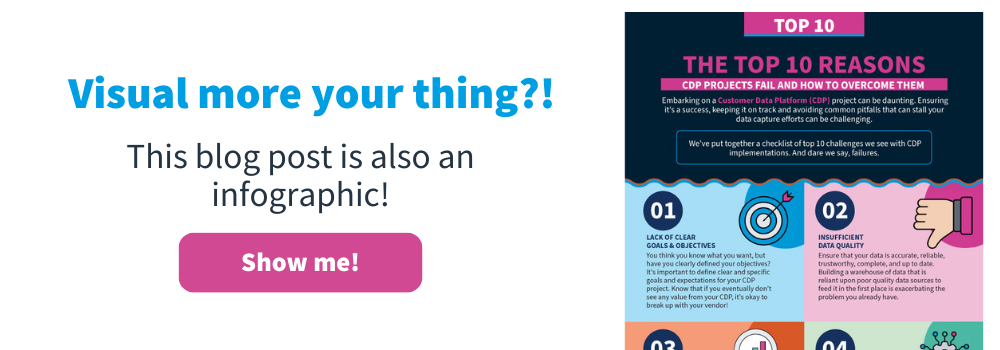You’ve identified the problem, run the needs analysis, and completed your research on the most up-to-date, shiny new CDP superstars – and you chose one! Your brand is ready to tackle a CDP implementation project and solve all the problems your brand faces with your customer data.
Except there’s one problem you didn’t account for – the majority of CDP projects fail.
But the good news is it’s not you – it’s them! CDP vendors promise the moon, but the reality is far from it.
We’ve put together a list of the top 10 challenges we see with CDP implementations so you can get ahead of these challenges, ensuring you’re capturing the customer data you need and it’s available to action when customers are taking action with your brand.
1. Lack of Clear Goals & Objectives
This seems like a no-brainer. You already did the needs analysis, right? You know what you need and how you’ll improve your business. But have you really dug into details?
It’s vital your team, and the departments looking to benefit from the data, clearly define specific goals and expectations for your CDP project. Get into the weeds. Understand the needs of each department, the expectations and assumptions, and future desires for leveraging the tech.
2. Insufficient Data Quality
Garbage in, garbage out. If you start with subpar data, it’s hard to overcome it. Building a warehouse of data that is reliant upon poor quality data sources to feed it in the first place is exacerbating the problem you already have. Ensure your data is accurate, reliable, trustworthy, complete, and up-to-date.
At the first sign that your CDP data quality isn’t what you thought it would be, head it off at the pass with a solution like Celebrus.
3. Gaps in Data
Gaps in data can largely be attributed to tagging and inaccuracy. If you don’t tag for it – you don’t capture it.
Look for a solution that makes tagging obsolete and helps you instill confidence with accurate data.
4. Data Integration
Sharing data across business systems seems like a no-brainer. If you have the data, why can’t you connect it?
Be sure you have a plan as to what and how you’ll connect systems and ensure you have the right APIs and expectations of the data connections. Ensure you’re using flexible data structures that don’t require extensive tagging and can adapt to diverse systems without complex coding.
5. Gaps in Digital Identity
If you can’t connect the dots of a single consumer’s activity across all interactions with your CDP, that’s a problem.
Unfortunately, most organizations work with flawed identity solutions that provide broken identities and disjointed profiles. Focus on ways to connect the dots of a single consumer’s activity across all channels and interactions.
6. The Myth of Privacy and Security
During a CDP deployment, it’s common to experience loss of ownership and control over your brand’s data. Compliance challenges and PII risks within system integrations are also a concern.
Ensure your data solution is 100% fully compliant and adheres to the highest privacy and security standards without a reliance on third-party cookies.
7. Gaps in ConnectivityDo you know how quickly your data will land in your systems? How fast will it be structured and available for use? If the answer isn’t milliseconds, you’re already behind. Hours, or even days, to connect data just doesn’t cut it.
To be successful, you need to have data available in the right format at the right time, all the time.
8. Ignoring Change Management
Website changes, code alterations, application updates, sub domain creation and user journey manipulations requires change management. And it becomes even more critical when solutions hinge solely on tagging and complex code to extract and collect digital data.
A data capture solution that doesn’t require tagging helps you to avoid these headaches.
9. Failure to Measure ROI
If you're unable to get a full view of your data set and of an individual customer, there’s no way you’ll be able to measure ROI. This limited connectivity leaves teams scrambling to understand the entire picture and determine the true data set.
Ensure you have a clear understanding of what good looks like and how your goals and expectations translate into tangible ROI.
10. Inadequate Scalability
With the volume of data exponentially growing, scalability is important. If your data structures are complex and you find yourself constantly altering or changing them, you don’t have an out-of-the-box solution that can adapt to shifting needs.
Look to the future, including future tech you’ll want to leverage and ensure your platform is configured with this in mind.
Improving customer relationships starts with the right data and that starts with the right data technology, deployed in the right way. You’ll need more than what a traditional CDP can typically offer. Don't waste resources on ineffective CDP solutions that won’t suit your business needs and will just leave you with frustrations and looking for yet another fix in a short time.

Tag management is dead
Manual tagging is a common practice to support digital marketing, but it's time-consuming and prone to error. Say goodbye to tag management and hello to a tagging-free data capture solution.








